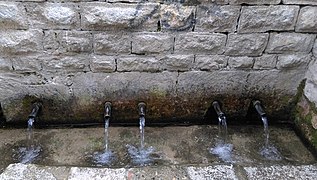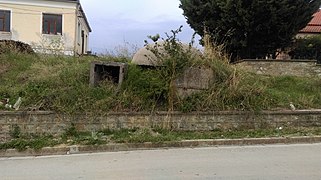Bilisht
Bilisht | |
|---|---|
UTC+2 (CEST ) | |
| Postal Code | 7006 |
| Area Code | (0)811 |
Bilisht (
Geography
The town of Bilisht is the most southeastern city of Albania. It is located to the east of the Devoll Valley, about 880-970m above sea level in a hilly relief that stretches from the Devoll River bed to Kokogllava hill over the city and covers an area of 1.4km2. With average altitude 925 m above sea level Bilisht is the second highest city in Albania after Ersekë (1020m above sea level).
The city has a very favorable geographic position as it passes through the motorway link connecting Albania with Greece via the Kapshticë customs that is 7 km east of it. In the north the town is bordered by Bitinckë (3 km east of it), east bounded by the hills of Kokogllava (1140m above sea level), Stranra (1280m above sea level), Sellcë (an early residence near Bilisht) and Vërnik, (5 km east), south is bordered by Vishoçicë (3 km south), while west is bordered by Devoll River and villages like Poloskë (4 km), Kuç (3 km), Baban (5.5 km ) and Hoçisht (6.5 km). Bilisht has a population of about 12,000 and is the capital of the Municipality of Devoll.
The tyrbe (tomb) of the Muslim Sufi saint Qazim Baba is located in Bilisht.[4]
Climate
The climate in Bilisht is Mediterranean transient, but with remarkable continental influence. The high sea level (930m), as well as the distance from the sea, makes the summer in Bilisht to be warm and fresh, with a cold and snowy winter, as well as with the fall of fresh autumn.
The average annual temperature is 9.9 degrees. The hottest month of the year is July with an average of 19.5 degrees C, where the highest and lowest temperatures range from 14 degrees in the night and 26.6 degrees during the day. The coldest month is January with an average of 0.2 degrees, with average temperatures ranging from -3.6 degrees at night and 4.1 degrees during the day. The maximum temperature was reached in July 1988 (39 degrees) while the minimum was reached in January 2012 (-20 degrees). The annual temperature range is 19.3 degrees.
The precipitation in Bilisht is lower than in other cities of Albania as a result of the strong continental and mountain ranges that surround this area. The average annual rainfall is 780mm. The largest amount of rainfall is reached in the spring and fall months: November (100mm) and October (89mm). Most of the precipitation is in May where on average there are 15 days of rainfall and 16 days of dryness. The driest months are August (39mm) and July (40mm). The highest number of dry days is August, where on average there are 23 dry days and 8 days of rainfall In the second half of autumn snowfall begins which falls until April. During the winter the largest amount of snowfall falls, mainly in January (4 days on average) and February (5 days on average). Usually snow precipitation may be present even in the spring months.
The frosts in Bilisht are present during the 8 months of the year, the month with the highest number of frosts is January (19 days), while the month with fewer days with frost is May (0.1 days) and October (1.3 days)
The wind at Bilisht is mainly blowing from the west and the north, the month with the highest wind speed is February with March (9 km / h), while the lowest speed is August at 6 km / h. The largest windmill is March, where the average wind speed averages 5 km / h over the course of 15 days, while the less windy month is October, where the wind averaged 5 km / h in 7 days.
Sunny days and sunset: The most sunny month is August, where on average there are 13 sunny days and 17 days partly cloudy or wintry, while the waning month is May where on average 25 days are cloudy or partly cloudy and 6 days with Sun.
History
A fortified location dating from the
Bilisht (

Following the
In the 1960s, the area around Bilisht and neighboring Korçë had the highest densities of population in mountainous districts within the country (500 metres and above).
Demographics
Ottoman geographer
During the 1980s, the population was 5600.[3] In post-communist Albania, Bilisht contains a mixed population of Muslims and Orthodox Christians.[14] In 1995, it had 8000 inhabitants[14] and 7000 in 2001.[26] Apart from the village of Vërnik, all other settlements of the Devoll region including Bilisht are populated by an Albanian speaking population.[14] A Romani community also exists in the town that settled in Bilisht during the 17th century.[27] In the late 2010s, the majority population of Bilisht is Muslim of the Bektashi Order.[28]
Education
An Ottoman Secondary school (rüştiye) was opened in Bilisht during 1881-1882.[7] Twelve years later it closed down due to a decrease of students and poor quality teaching from its lone educator.[7] It was transformed into a primary school by the early 1890s.[7] In the mid 1890s it had reverted to a secondary school and was the smallest in the region.[7] By the 1900s, it had two teachers and around 20 students.[7]
A Greek language school was already operating in Bilisht in 1888, while Greek education was still present during the 1912-1914 period.[29] Located outside of Albania's official Greek minority zone, post communist Bilisht has a Greek language and cultural tutoring centre.[30]
In modern Bilisht, there are two Albanian primary schools, "Myteza Sala" with 15 teachers and "Dritëro Agolli" with 10 teachers.[31] Bilisht has an Albanian elementary school "Fuat Babani" and it caters for up to 800 students.[32] It was completely reconstructed and modernised through a €600,000 investment by the TAP pipeline in 2018.[32]
Governance
The municipal council for Devoll composed of 17 members is located in Bilisht.
Popular culture
The town of Bilisht is the location for events in an
Gallery
-
Centre of Bilisht
-
"Devolli" Stadium
-
"Çezma e Madhe" (large water fountain), erected 1914-1918
-
Communist era bunker
-
Monument to local victims of communism
-
Bilisht and Orthodox Church (far right corner)
-
Halveti tekke
-
Streetscape in Bilisht
-
Houses in Bilisht
References
- ^ "Law nr. 115/2014" (PDF) (in Albanian). pp. 6372–6373. Retrieved 25 February 2022.
- ^ 2011 census results Archived 2015-09-24 at the Wayback Machine
- ^ ISBN 9783486558487.
- ^ Elsie, Robert (2000). "The Christian Saints of Albania". Balkanistica. 13 (36): 53.
- ISBN 978-9025610517.
- ^ Lehce-i Osmani. "بهلشته - Bihlişte". Retrieved 12 December 2021.
- ^ a b c d e f Bedirhan, Hasan Çağri (2019). Serficede modern eğitim kurumları (1875-1912) [Modern Educational Institutions in Serfice (1875-1912)] (PDF) (Masters). Necmettin Erbakan University. pp. 32–33. Retrieved 12 December 2021.
- ISBN 9783631602959.
- ISBN 9783447030885.
- ISBN 9783447044875.
- ^ Cuaz, Marco (1996). "Il tema dell'identità nazionalenella storiografia albanese". Passato e Presente. XIX (39): 99. "trattato russo-turco di Santo Stefano del 3 marzo 1878 che avrebbe fissato le «indiscutibili frontiere etniche bulgare», occupando i territori albanesi di Korcia, Bilisht, Pogradec, Struge, Dibër, Gostivar, Kaçanik e Kumanove."
- ISBN 9789540105581.
- ^ a b Vullnetari 2007, p. 21.
- ^ ISBN 9783643501448.
- ISBN 9783631602959.
- ^ Vullnetari 2007, p. 17.
- ^ Vullnetari, Julie (September 2007). "Albanian Migration and Development: State of the art review". IMISCOE (International Migration, Integration and Social Cohesion). p. 75. Retrieved 14 September 2019.
- ^ a b Da Costa, Brandon (2019). Part I - Delirious Underground, Part II - Model Homes for Paranoia (Masters). University of British Columbia. p. 83. Retrieved 15 December 2021.
- ^ a b De Rapper, Gilles (2008). "Religion in post-communist Albania: Muslims, Christians and the concept of 'culture' (Devoll, South Albania)". Anthropological Notebooks. 14 (2): 41.
- ^ Vullnetari 2012, pp. 115, 209.
- ISBN 9782811103903.
- ^ Vullnetari 2012, p. 209.
- ISBN 9788021089822.
- ^ Tarsoudi, Vasiliki (2021). Το δίκαιο μεταφοράς φυσικού αερίου στην ΕΕ και ειδικότερα το καθεστώς του αγωγού TAP και το σύμφωνο φιλοξενούσας χώρας (Masters) (in Greek). Democritus University of Thrace. p. 21. Retrieved 8 January 2022.
- ^ ISBN 9789548872454. "Етническата граница между българи и албанци оставя двете български села като остров сред албанското население още вначалотона XIX в. Тогава тази граница е преминавала пò на изток, някъде в района на градчето Биглища. В 1805–1807 г. През Албания минал англичанинът Уилям Лийк. Според него границата настраната била селището Биглища, тъй като жителите му говорели албански. Всредатана XVII в. Турският географ Хаджи Калфа в своето описание на Европейска Турция обаче отбелязва, че жителите на нахия Биглища са българи и арнаути. Християнското население на тази област намалявало най-вече поради изселване в други крайща и приемане наисляма."
- ISBN 9789089643551.
- ISBN 9783643501448.
- ISBN 9781350226142. "Bilisht town is majority Bektashi/Muslim"
- ^ Koltsida, Athina. Η Εκπαίδευση στη Βόρεια Ήπειρο κατά την Ύστερη Περίοδο της Οθωμανικής Αυτοκρατορίας [Education in Northern Epirus during the Later Ottoman Period] (PDF) (in Greek). University of Thessaloniki. p. 138. Retrieved 2 December 2021.
- University of Thessaloniki. pp. 118–119. Retrieved 6 February 2013.
Έτσι, αν και η περιοχή επίσημα (Këshilli i Ministrave,2001) δεν χαρακτηρίζεται «μειονοτική»,... Γι' αυτό το λόγο, δημιουργήθηκε Φροντιστηριακά Τμήματα εκμάθησης ελληνικής γλώσσας και πολιτισμού, τόσο στην έδρα του Συλλόγου, την πόλη της Κορυτσάς, αλλά και ένα δίκτυο Φροντιστηριακών Τμημάτων που επεκτείνεται ραγδαία στην ευρύτερη περιφέρεια της περιοχής (Λεσκοβίκι, Ερσέκα, Βιθκούκι, Μπομποστίτσα, Μπιλίστι, Πόγραδετς, Μοσχόπολη, Πογιάνι, Ποροντίνα, Πολένα, Χοτσίστι, Ρεμπέτσι κ.ά).
- ^ Pylli, Evionda (2–3 May 2019). Challenges of acquiring scientific knowledge for students of pre-university education and teacher responsibilities in the classroom environment. Village Institutes and New Searches in Education. Çanakkale: Rating Academy (Çanakkale Onsekiz Mart University). p. 244. Retrieved 12 December 2021.
- ^ a b "TAP rikonstrukton shkollën "Fuat Babani" në Bilisht me 600 mijë euro" [TAP reconstructs the school "Fuat Babani" in Bilisht with 600 thousand euros] (in Albanian). Koha Jone. 20 May 2018. Retrieved 7 January 2022.
- ^ Central Election Commission of Albania. 2011. Archived from the originalon 5 July 2015. Retrieved 10 March 2012.
- ISBN 9780821361719.
- ISBN 9781315287430.
Several other anti-Greek incidents are reported on the eve of the elections. For example, Thanasi Jorgji from the village of Bilisht, province of Korce, withdraws his candidacy after local Albanians threatened to burn down his house.
- ISBN 9780226779720.













